
How to Use solar charge controller: Examples, Pinouts, and Specs
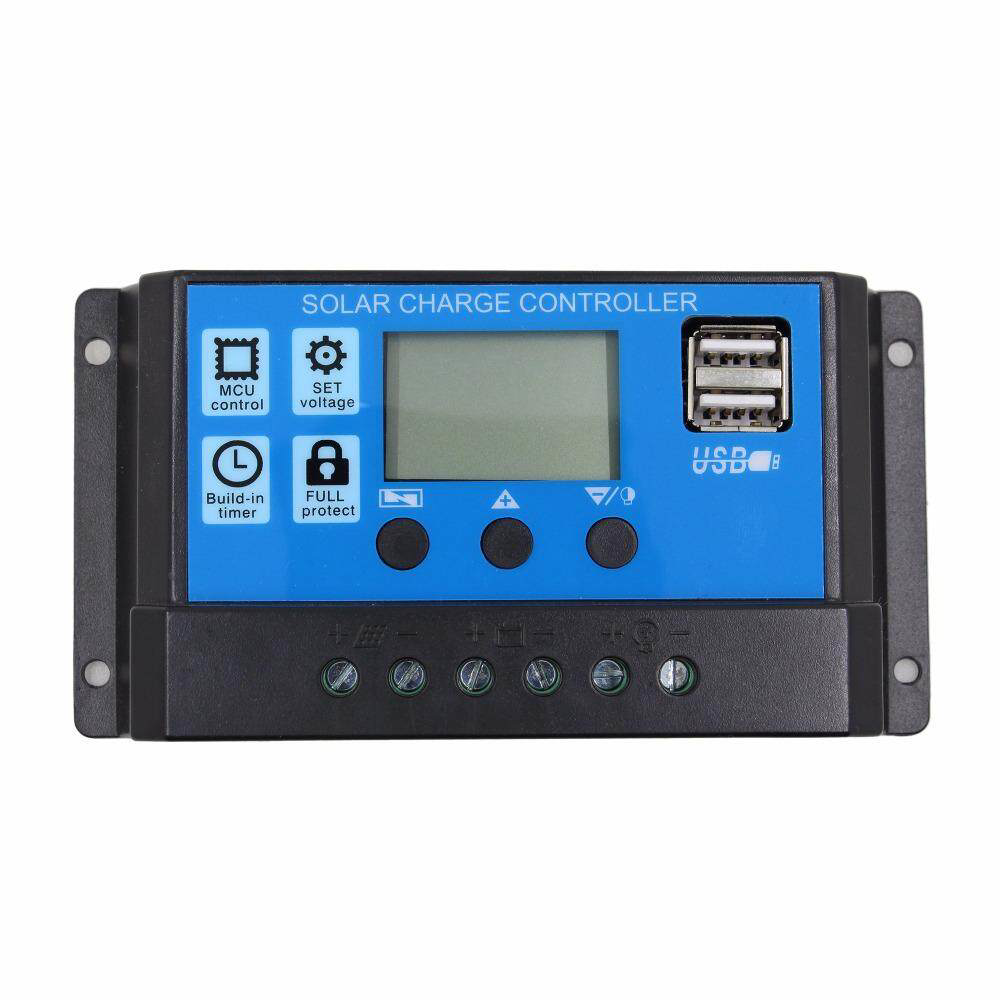
 Design with solar charge controller in Cirkit Designer
Design with solar charge controller in Cirkit DesignerIntroduction
The Solar Charge Controller (Manufacturer: sfijd-0, Part ID: dmgowfow) is a critical component in solar power systems. It regulates the voltage and current coming from solar panels to prevent overcharging of batteries, ensuring efficient energy storage and prolonging battery life. By managing the energy flow, it protects batteries from damage and enhances the overall performance of the solar power system.
Explore Projects Built with solar charge controller
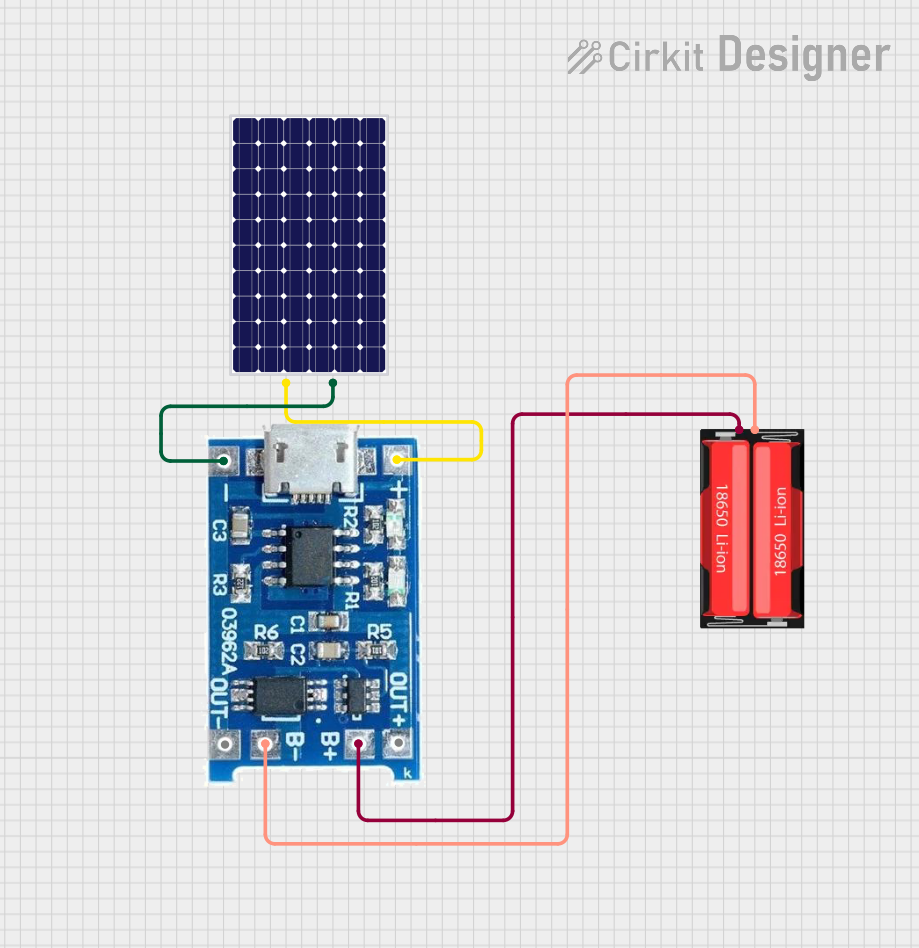
 Open Project in Cirkit Designer
Open Project in Cirkit Designer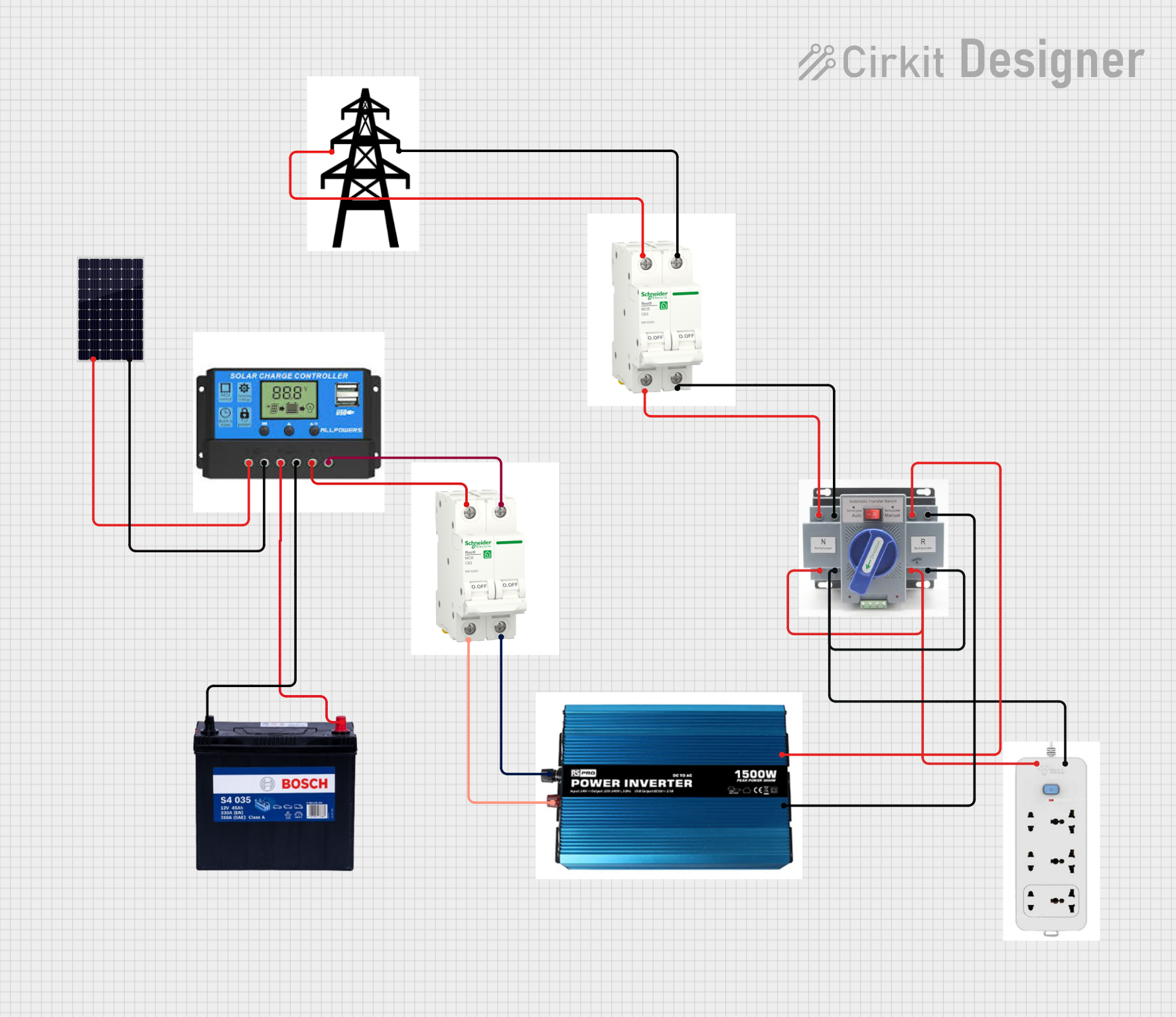
 Open Project in Cirkit Designer
Open Project in Cirkit Designer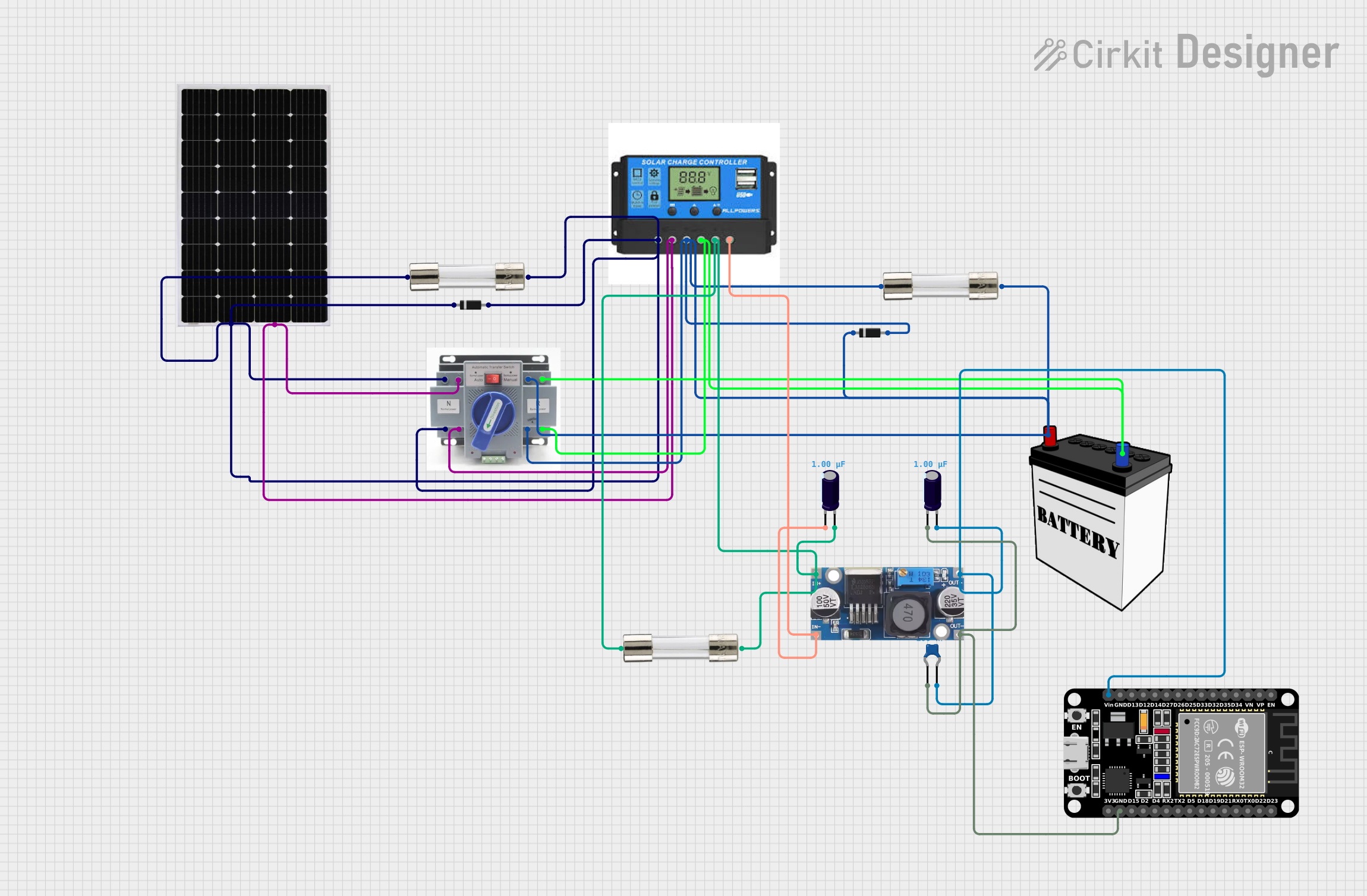
 Open Project in Cirkit Designer
Open Project in Cirkit Designer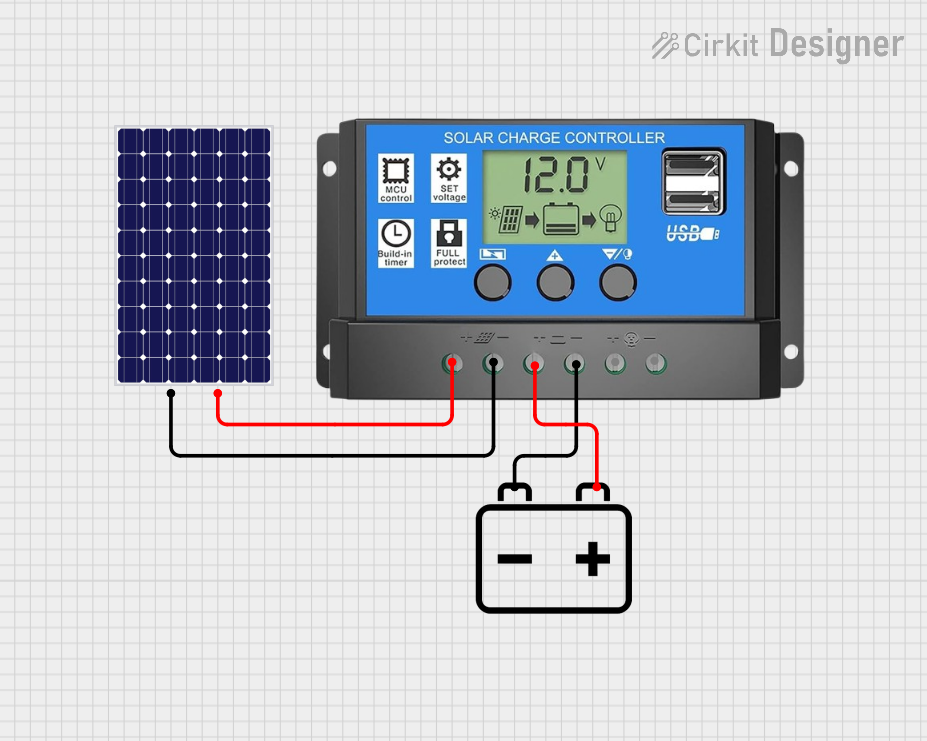
 Open Project in Cirkit Designer
Open Project in Cirkit DesignerExplore Projects Built with solar charge controller

 Open Project in Cirkit Designer
Open Project in Cirkit Designer
 Open Project in Cirkit Designer
Open Project in Cirkit Designer
 Open Project in Cirkit Designer
Open Project in Cirkit Designer
 Open Project in Cirkit Designer
Open Project in Cirkit DesignerCommon Applications and Use Cases
- Solar-powered home energy systems
- Off-grid solar installations
- Solar-powered streetlights
- Portable solar charging systems
- RVs, boats, and other mobile solar setups
Technical Specifications
The following table outlines the key technical details of the sfijd-0 dmgowfow solar charge controller:
| Parameter | Value |
|---|---|
| Input Voltage Range | 12V to 24V (auto-detect) |
| Maximum Input Current | 20A |
| Output Voltage Range | 12V or 24V (based on battery type) |
| Maximum Output Current | 20A |
| Efficiency | ≥ 95% |
| Battery Type Supported | Lead-acid, Lithium-ion, LiFePO4 |
| Operating Temperature | -20°C to 60°C |
| Protection Features | Overcharge, Over-discharge, |
| Overload, Short Circuit |
Pin Configuration and Descriptions
The sfijd-0 dmgowfow solar charge controller has the following terminal connections:
| Pin/Terminal | Label | Description |
|---|---|---|
| 1 | Solar Panel (+) | Positive terminal for solar panel input |
| 2 | Solar Panel (-) | Negative terminal for solar panel input |
| 3 | Battery (+) | Positive terminal for battery connection |
| 4 | Battery (-) | Negative terminal for battery connection |
| 5 | Load (+) | Positive terminal for DC load output |
| 6 | Load (-) | Negative terminal for DC load output |
Usage Instructions
How to Use the Solar Charge Controller in a Circuit
- Connect the Solar Panel:
- Attach the positive and negative terminals of the solar panel to the corresponding Solar Panel (+) and Solar Panel (-) inputs on the charge controller.
- Connect the Battery:
- Connect the positive and negative terminals of the battery to the Battery (+) and Battery (-) terminals on the charge controller.
- Connect the Load:
- If you have a DC load (e.g., LED lights, small appliances), connect it to the Load (+) and Load (-) terminals.
- Power On:
- Once all connections are secure, the charge controller will automatically detect the system voltage (12V or 24V) and begin regulating the energy flow.
Important Considerations and Best Practices
- Battery Compatibility: Ensure the battery type is supported (e.g., Lead-acid, Lithium-ion, or LiFePO4).
- System Voltage: Use solar panels and batteries with matching voltage ratings (12V or 24V).
- Wiring: Use appropriately rated wires to handle the current without overheating.
- Placement: Install the charge controller in a well-ventilated area to prevent overheating.
- Polarity: Double-check all connections to avoid reverse polarity, which can damage the controller.
Arduino UNO Integration Example
The solar charge controller can be monitored using an Arduino UNO to track battery voltage and solar panel performance. Below is an example code snippet:
// Example: Monitor battery voltage using Arduino UNO
// Connect the battery's positive terminal to an analog pin (e.g., A0) via a voltage divider.
const int batteryPin = A0; // Analog pin connected to the battery voltage divider
float voltage = 0.0;
void setup() {
Serial.begin(9600); // Initialize serial communication
}
void loop() {
int sensorValue = analogRead(batteryPin); // Read the analog value
voltage = sensorValue * (5.0 / 1023.0) * 2;
// Convert to voltage (assuming a 2:1 voltage divider)
Serial.print("Battery Voltage: ");
Serial.print(voltage);
Serial.println(" V");
delay(1000); // Wait 1 second before the next reading
}
Note: Use a voltage divider circuit to step down the battery voltage to a safe range (0-5V) for the Arduino's analog input pins.
Troubleshooting and FAQs
Common Issues and Solutions
No Output from the Controller
- Cause: Incorrect wiring or loose connections.
- Solution: Verify all connections and ensure proper polarity.
Battery Overcharging
- Cause: Incorrect battery type setting or faulty controller.
- Solution: Check the battery type setting and ensure it matches the connected battery.
Load Not Powering On
- Cause: Load current exceeds the controller's maximum output.
- Solution: Use a load within the controller's rated current capacity (20A max).
Controller Overheating
- Cause: Poor ventilation or excessive current draw.
- Solution: Install the controller in a well-ventilated area and reduce the load.
FAQs
Q1: Can I use this charge controller with a 48V system?
A1: No, the sfijd-0 dmgowfow charge controller supports only 12V and 24V systems.
Q2: How do I know if the battery is fully charged?
A2: The charge controller typically has an LED indicator or display to show the battery's charge status.
Q3: Can I connect multiple solar panels to this controller?
A3: Yes, but ensure the combined voltage and current of the panels do not exceed the controller's input limits (24V, 20A).
Q4: Is this controller waterproof?
A4: No, it is not waterproof. Install it in a dry, protected location.
By following this documentation, you can effectively integrate and maintain the sfijd-0 dmgowfow solar charge controller in your solar power system.